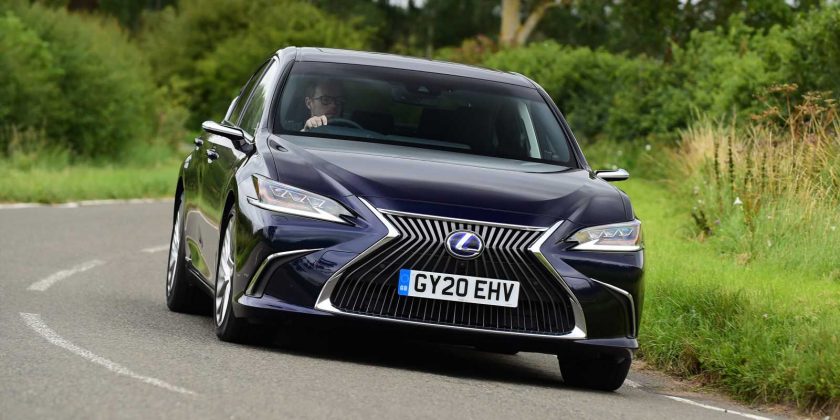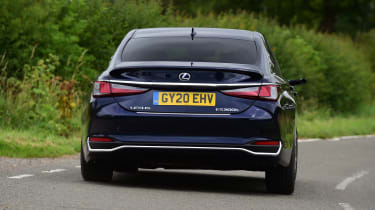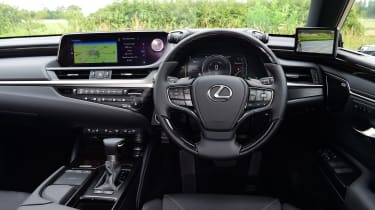Lexus has added ‘Digital Side-View Monitors’ to the top spec Takumi version of its ES saloon in place of regular side mirrors, but it needn’t have bothered.
3.5 out of 5
Verdict
Lexus’s digital wing mirrors add expense to its top-spec ES Takumi model, yet the tech is flawed for a few reasons. Otherwise, it’s business as usual for the ES, which means it’s high quality, refined and efficient, but not quite as comfortable or as good to drive as the best in the class. It’s disappointing that the brand has added unnecessary tech with its wing mirrors rather than addressing the car’s weak infotainment system, which could definitely do with an update.
There isn’t all that much new about this particular Lexus ES, except for one detail you might have spotted from our exterior pictures – the Japanese brand’s executive saloon is now available with digital wing mirrors.
Lexus actually calls them ‘Digital Side-View Monitors’. They’re only available on top-spec Takumi trim and add £1,600 to the price of the car, taking the total for this model to £47,280.
Best executive cars 2020
We’ll cut to the chase, at that price the technology isn’t good enough and doesn’t add sufficient extra usability to warrant the increased spend. In fact, the digital wing mirrors are actually less useful than the standard car’s mirrors.
That’s because the resolution of the picture displayed on the screens – one mounted on the passenger side A-pillar, the other mounted close to you on the driver’s side windscreen pillar – isn’t clear enough.
Add to that the fact there’s too much lag between what the digital cameras ‘see’ and how quickly this is displayed on the screen and it’s hard to say that you always know where other cars are around you on a dual-carriageway or motorway.
There are other problems to digital wing mirror tech that are not just limited to the Lexus. For example, with a conventional mirror your eyes’ focal point is some way behind you at the point you have learnt to look for after years of using conventional mirrors.
In a car with digital mirrors, the focal point is the screen just a few feet from your eyes. It takes some getting used to this phenomenon and it’s the same with the system in the Honda e, or with Land Rover’s digital rear-view mirror, for example.
The other problem is that when you change your angle of view in a conventional car by craning your neck or turning your head, it’s met by an equal response in what you can see in the mirror. Lexus says the tech aims to reduce this movement, but we found it didn’t.
With a screen the picture never changes, you sometimes find yourself moving about to get a better view of the area behind you when changing lanes – but to no benefit, as you still end up trying to look at the same image on the screen.
There are some useful lines that appear on the screens to mark safe distances when it comes to changing lanes after you’ve passed a car or pulling out to overtake a slower one, but the tech still has some way to go before it’ll be more intuitive than a regular mirror.
The screen positioning in the ES isn’t ideal either, with the two five-inch panels placed at significantly different angles.
Otherwise, in high-spec Takumi trim, the ES is as good as it ever was. The 215bhp 2.5-litre four-cylinder hybrid powertrain is quiet most of the time, the CVT automatic gearbox keeping revs relatively low and managing the two different power sources smoothly.
It’s fast enough as well. While the noise increases as the engine is held at the optimum point for maximum performance, the 0-62mph sprint takes 8.9 seconds.
Claimed fuel efficiency stands at 53.2mpg with emissions at 119g/km, the ride is comfortable enough and in Takumi spec there’s lots of equipment. Lexus Safety System+ is standard, offering plenty of protective tech and systems – sat-nav, matrix LED lights, a power tailgate and head-up display, heated and cooled leather seats and a reversing camera that displays on an eight-inch screen are all standard.
The infotainment is displayed on this central screen but uses an infuriating touch pad that makes it very difficult to find and select the option you want – it’s better to use either Android Auto or Apple CarPlay tech, which Lexus now offers.
Thankfully, the ride is just soothing enough and refinement solid so as to ease the frustrations with the infotainment, just don’t expect it to handle like a BMW 5 Series or even a Mercedes E-Class.
| Model: | Lexus ES |
| Price: | £47,280 |
| Engine: | 2.5-litre 4cyl petrol hybrid |
| Power: | 215bhp |
| Transmission: | CVT automatic, front-wheel drive |
| 0-62mph: | 8.9 seconds |
| Top speed: | 112mph |
| Economy/CO2: | 53.2mpg/119g/km |
| On sale: | Now |
Source: Read Full Article



 Best executive cars 2020
Best executive cars 2020
